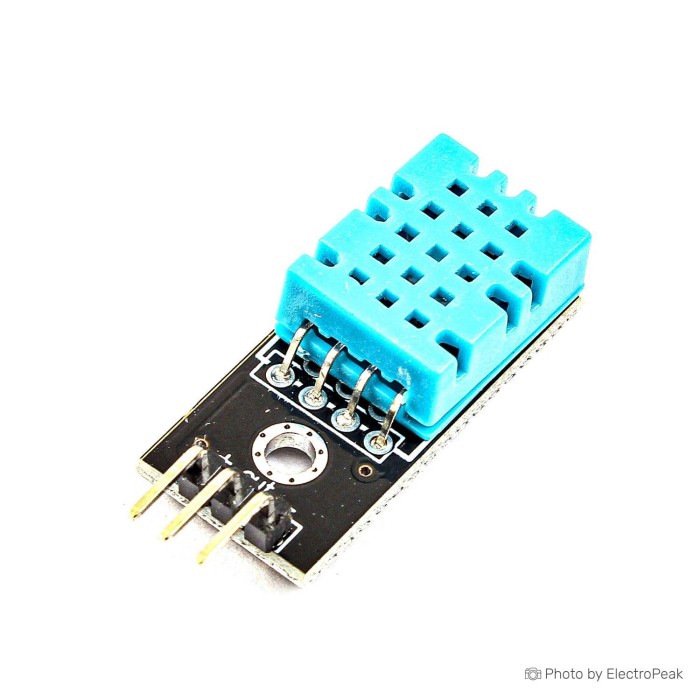DHT11 Temperature Humidity Sensor Module
Volume discounts:
- +100 6 % $0.6100
- +300 8 % $0.6000
- +500 11 % $0.5800
- +1000 12 % $0.5700
 AHT10 Digital Temperature and Humidity Sensor Module
Previous
AHT10 Digital Temperature and Humidity Sensor Module
Previous

The DHT11 Temperature Humidity Sensor Module is a compact and affordable sensor module that provides accurate measurements of temperature and humidity. It is widely used in various applications, including environmental monitoring, home automation, weather stations, and more. This module integrates the DHT11 sensor and necessary components for easy interfacing with microcontrollers or other devices.
Specifications of DHT11 Temperature Humidity Sensor Module
- Sensor Type: DHT11
- Operating Voltage: 3.3V - 5V
- Temperature Measurement Range: 0°C to 50°C (32°F to 122°F)
- Temperature Measurement Accuracy: ±2°C (±3.6°F)
- Humidity Measurement Range: 20% RH to 90% RH
- Humidity Measurement Accuracy: ±5% RH
- Signal Output: Digital signal (single-wire communication)
- Refresh Rate: Approximately 1 Hz
- Communication Protocol: Single-wire communication protocol (proprietary)
- Size: 34*13mm
Key features of DHT11 Temperature Humidity Sensor Module
- Dual Measurement: The DHT11 sensor provides both temperature and humidity measurements in a single module.
- Wide Operating Voltage: It can operate in a voltage range of 3.3V to 5V, making it compatible with various microcontrollers and development boards.
- Accuracy: Although it is a cost-effective sensor, it offers reasonable accuracy for most applications.
Usage Tips of DHT11 Temperature Humidity Sensor Module:
- Connect the sensor module to your microcontroller or development board using the single-wire communication protocol. Ensure that you provide the required voltage within the specified range (3.3V - 5V). Our suggestion for new users is to use Arduino boards. For example, you can use Arduino UNO board.
- The DHT11 performs optimally within a specified temperature and humidity range. Ensure your project aligns with these conditions for accurate readings.
- While the sensor has a reasonable level of accuracy, periodic calibration against a reliable reference can improve its performance over time.
- Maintain a stable power supply to the sensor for consistent and reliable measurements.
- To obtain accurate readings, avoid exposing the sensor to extreme conditions, such as direct sunlight or rapid temperature changes.
- Handle the module with care to prevent damage to the sensor element.
- Ensure that the wiring and connections are correct to avoid signal errors.
Types of DHT series temperature and humidity sensors
The DHT series comprises various temperature and humidity sensors, including the DHT11, DHT22 (also known as AM2302), and DHT21. Each sensor has its own set of characteristics and specifications. Here's a comparison of these popular DHT temperature and humidity sensors:
DHT22 (AM2302):
- Temperature Range: -40 to 80 degrees Celsius
- Humidity Range: 0% to 100% RH
- Accuracy: ±0.5°C for temperature, ±2% for humidity
- Refresh Rate: 0.5 Hz
- Operating Voltage: 3 to 5.5V
- Single-Wire Interface: Yes
- Cost: Higher compared to DHT11
DHT21:
- Temperature Range: -40 to 80 degrees Celsius
- Humidity Range: 0% to 100% RH
- Accuracy: ±0.5°C for temperature, ±3% for humidity
- Refresh Rate: 0.5 Hz
- Operating Voltage: 3 to 5.5V
- Single-Wire Interface: Yes
- Cost: Similar to or slightly higher than DHT11
Comparison:
- Temperature Range: DHT22 and DHT21 have a wider temperature range compared to DHT11, making them suitable for more diverse environments, including extreme conditions.
- Humidity Range: All three sensors cover a broad humidity range, but DHT22 and DHT21 provide a more accurate representation, especially at higher humidity levels.
- Accuracy: DHT22 and DHT21 offer better accuracy for both temperature and humidity compared to DHT11. This makes them more suitable for applications where precision is crucial.
- Refresh Rate: DHT22 and DHT21 have a slightly higher refresh rate compared to DHT11, providing more frequent updates of environmental data.
- Cost: DHT11 is generally the least expensive among the three, making it a popular choice for budget-friendly projects. DHT22 tends to be more expensive due to its higher accuracy and extended range.
Use Case Recommendations:
- DHT11: Suitable for basic projects where cost is a significant factor, and precision is not critical.
- DHT22 (AM2302) or DHT21: Ideal for applications requiring higher accuracy and a wider operating range, such as weather stations, greenhouse monitoring, or critical environmental control systems.
In summary, the choice between DHT11, DHT22, or DHT21 depends on the specific requirements of your project, considering factors like cost, accuracy, temperature range, and humidity sensitivity.





Please complete your information below to login.
Sign In
Create New Account